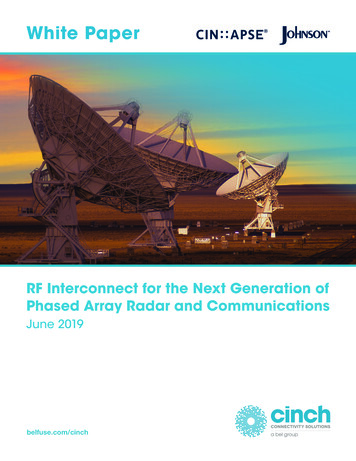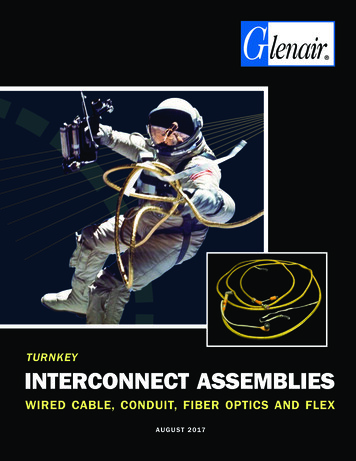
Transcription
White PaperRF Interconnect for the Next Generation ofPhased Array Radar and CommunicationsJune 2019belfuse.com/cinch
RF INTERCONNECT FOR THE NEXT GENERATION OF PHASED ARRAYRADAR AND COMMUNICATIONSAbstractThe latest phased array radar and communications systems being developed for Actively Electronically ScannedArray (AESA), 5G and Tactical communications are following trends of higher frequency operation and physicaldensification. With greater numbers of antenna elements, transmit/receive modules, antenna processors, and otheranalog/hybrid/digital beamforming modules in a single phased array antenna system, additional RF interconnectdesign considerations emerge. These new designs involve fitting a greater number of RF connectors and cableassemblies that also house more integrated PCBs that support analog, digital, and RF circuits. Reducing the size,weight, cost, and installation complexity of RF interconnects must also be considered.This article aims to educate engineers and industry professionals working with phased array antenna systems forradar and the new design considerations and solutions that help mitigate the challenges associated with building thenext generation of phased array radar.Phased Array Radar TrendsPhased array antennas, and subsequent radar and communication systems, benefit from the physics ofelectromagnetics, in that the size of optimized RF structures is inversely proportional to the frequency at whichthey operate. This means that antennas built for higher frequencies are smaller and otherwise more compact thanantennas for lower-frequency applications. In the case of multi-element antennas, such as phased array antennas,this means that increasing the operating frequency has a dramatic impact on the size, weight, cost, and even powerof these systems.There is a caveat, however, in that a variety of losses, such as RF loss and atmospheric attenuation, are also greaterat higher frequencies. These additional losses can be compensated for by adding additional antenna elements inphased array radars. Moreover, incorporating active phase and amplitude control enables an operator or algorithm toprecisely control the antenna pattern of a phased array antenna. In the case of AESA radars, jammers, and TacticalCommunications, this ability is critical in avoiding harm to sensitive receivers, or more effectively controlling beampatterns to target enemy radar or friendly communications. This ability has given rise to a variety of actively controlledantenna techniques that allow for low-probability of intercept/low-probability of detection (LPI/LPD).Moreover, at higher frequencies, the beam width of an antenna becomes more narrow, enhancing the directivity overa comparable, but lower-frequency, multi-element antenna. These factors have given rise to the interest in usingmillimeter-wave (mmWave) phased array antennas for radars, jammers, Tactical Communications, and upcomingmmWave 5G communications [1, 2, 3]. Though the compact nature of mmWave antennas becomes attractive from asize, weight, power, and cost (SWAP-C) perspective, the reduction in overall antenna size, alongside the dramaticResources and References1. eter-wave-program2. tal-arrays3. 541528087/
RF INTERCONNECT FOR THE NEXT GENERATION OF PHASED ARRAYRADAR AND COMMUNICATIONSincrease in antenna elements, means that the associated RF interconnect must also be contained within thesereduced-size modules. High-density RF interconnect, which still meet stringent MIL-SPEC ruggedness requirements,are necessary to provide the interconnect between the growing diversity of transmit/receive (TR) modules, AntennaProcessing Units (APUs), hybrid-beamforming circuitry, and/or analog beamforming components.High-quality RF interconnect that meet the SWAP-C requirements of these new phased array antenna systems isessential during the prototyping, testing, and production phases, and are also key components of deployed phasedarray systems. With the intended use cases of mmWave 5G extending to industrial, automotive, and infrastructureapplications, it is likely that many of the same ruggedization and reliability requirements used by military/aerospacemarkets will extend to mmWave 5G.Phased Array Radar Signal ChainA basic phased array antenna consists of RF interconnect, attenuators/amplifiers, phase shifters, and antennaelements. In this basic case, RF interconnect is needed to connect between the transmitter, receiver, circulator/isolator/switch, attenuators/amplifier, phase shifter, and antenna elements. Another topology (that is becoming increasinglycommon) is the use of TR modules, which place the transmitter power amplifier (PA) and receiver low noise amplifier(LNA) in a module that is then connected through the same RF path to switches/circulators from the phase shifter tothe antenna element. TR modules are used to enable the benefits of integration and modularity, further reducing theoverall size of the antenna. This approach tends to require much smaller-pitch and higher-density RF interconnectthan basic phased array antennas, as using larger RF interconnect negates many of the size and weight benefits ofmmWave reduced element size.The next level of this integration is to use hybrid, or digital, beamforming phased array antenna topologies that allowfor much more compact components, such as System-on-Chip (SoC), System-in-package (SiP), integrated RF frontend modules, APU ASICs, and other types of compact assemblies, modules, or ICs. Hybrid and digital beamformingenable much more compact phased array antennas and can employ high-speed digital communications instead ofRF communications between the modulation circuitry and the RF circuitry. In these cases, even tighter-pitch andhigher-density RF interconnect are needed to provide connections between the high-speed communication buses ofthe modems and the beamforming electronics.Though jammers and some lower-frequency radars will require larger-sized RF components and interconnect dueto the power requirements of such systems, both Tactical Communications and mmWave 5G communications arelikely to continue to greater levels of integration and densification. The need for this stems from reducing SWAP-Cparameters and enabling the deployment of massive numbers of mmWave base stations, which would otherwise belimited if the SWAP-C parameters of the communication systems were comparable to radar and jammer systems.The densification of mmWave phased array antenna systems also brings into consideration the sensitivity of sucha system to external and internal interference, especially when considering the high-speed data lines and multitudesof low-power mmWave RF interconnect inevitable in communication systems. Coaxial cable assemblies andinterconnect are excellent at providing shielded communications with minimizing insertion loss and attenuation.This concept also applies to highly sophisticated radar, which uses many of the same modulation technologies(spread spectrum) as modern communications. Hence, there is, and will be, a growing need for a wide range ofhigh-density RF interconnect technologies, from ruggedized SMA cable assemblies to compact ultra-miniatureganged connector modules.belfuse.com/cinch
RF INTERCONNECT FOR THE NEXT GENERATION OF PHASED ARRAYRADAR AND COMMUNICATIONSEven with greater integration, RF interconnect is still needed for high-speed digital signals andoutput to the antenna elements, though the interconnect will likely need to be denser.RF Interconnect Design Considerations for Phased Array AntennaThough radar, jamming, Tactical Communications, and mmWave 5G communications have very different end-goalsand deployment scenarios, many of the RF interconnect considerations are the same. The following sections arededicated to discussing the top design considerations for mmWave phased array antenna systems and includeapplication-specific details and examples.Phase Stability and Phase Matched Coaxial Cable AssembliesThe benefits of a phased array antenna are derived by the ability to precisely control the phase of the RF signal atthe output of the antenna. This is only possible if the phase of the signal is stable and predictable throughout thephased array antenna system signal chain. There are two main RF interconnect considerations in this area. One isthe phase stability of signals passing through a coaxial cable, based on environmental factors such as shock, vibration,flexure, warp, temperature, etc. Using “phase stable” coaxial cables helps to ensure that environmental influenceis minimized.
RF INTERCONNECT FOR THE NEXT GENERATION OF PHASED ARRAYRADAR AND COMMUNICATIONSThe other consideration is the phase match between the coaxial cables used. Systematic phase error could beintroduced by the coaxial cable production process, leading to even same-length coaxial cables exhibiting variancesin the phase response. Hence, using phase-matched coaxial cables (which are cables ordered to have an incrediblysimilar phase response) can help to eliminate the concern of phase variances from RF interconnect and enhancepredictability and performance of phased array antenna systems.Mechanically Robust ConnectionsMilitary/aerospace manufacturers are required to use MIL-SPEC coaxial cables,connectors, and assemblies, which must meet a minimum standard of ruggednessand reliability. These standards include resilience to damage from shock, vibration,thermal cycles, and environmental agents. Especially with highly sensitive phased arrayantenna systems operating at mmWave frequencies, mechanical reliability is essentialfor all mission-critical RF communications, radar, and jamming. Even slight mechanicalforces, if allowed to affect a phased array antenna system, could reduce overall systemperformance, produce hard-to-identify transient failures, or otherwise render the systeminoperable.Many of these high-reliability (Hi-Rel) standards also overlap with automotive andaviation standards, which will likely also impact upcoming mmWave 5G communicationconsiderations. Therefore, for critical applications, such as industrial automation,automotive, and aviation, upcoming 5G systems may also be required to employHi-Rel coaxial interconnect or otherwise reliability-qualified coaxial interconnect.mmWave Phased Array Connectors and CablesRecent Tactical Communication and mmWave 5G communications are investigating using frequencies well beyond18 GHz. At these frequencies, common RF coaxial interconnect (such as N-type, common SMA, SMB, etc.) are nolonger viable due to the way electromagnetic waves traverse through coaxial structures. Therefore, physically smallerconnectors are required for these new frequencies of interest, such as 2.92mm, 2.4mm, 1.85mm, high-frequencySMA, SMP, and SMPM, such as from Cinch’s JohnsonTM. The same concept applies to coaxial cables as well, asthe size of the coaxial transmission line also determines the upper frequency at which a transverse electromagnetic(TEM) mode can be maintained. Conversely, the size of a coaxial connector and cable also influences the path loss,power handling, and mechanical strength of a coaxial cable assembly. Advanced materials and fabrication methodscan be used to mitigate some of the negative performance effects of smaller coaxial transmission lines operating atmmWave frequencies.belfuse.com/cinch
RF INTERCONNECT FOR THE NEXT GENERATION OF PHASED ARRAYRADAR AND COMMUNICATIONSJohnsonTM Connector Offering Across FrequencyConnector TypeFrequency RangeCouplingFamily1.85mm*DC to 65 GHzThreadedSub-miniatureSMPM / GPPO*DC to 65 GHzSnap On - Blind mateMicro-miniature2.4 mmDC to 50 GHzThreadedSub-miniature2.92 mm / SMK*DC to 40 GHzThreadedSub-miniatureSMA / GPO*DC to 40 GHzSnap On - Blind mateMicro-miniatureSMADC to 18 / 26.5 GHzThreadedSub-miniatureKqiQMAte / QMADC to 12.4 GHzSnap OnSub-miniatureType NDC to 11 GHzThreadedStandardSMCDC to 10 GHzThreadedSub-miniatureMCXDC to 6 GHzSnap OnSub-miniatureMMCXDC to 6 GHzSnap OnMicro-miniatureUMX / u.FLDC to 6 GHzSnap On - Insertion ToolUltra-miniatureSMBDC to 4 GHzSnap OnSub-miniatureSMB - Mini - 75OhmDC to 2 GHzSnap OnSub-miniatureLow-Profile and Tight-Pitch InterconnectmmWave coaxial connectors’ smaller physical dimensions enable higher-frequency operation and muchhigher-density interconnect. Where larger coaxial connectors require threaded bodies for good mechanical/electricalcontact, smaller connectors can benefit from slide-on/snap-on interfacing. This factor removes the need for extrapitch distances to be maintained for nut-tightening tools, such as torque wrenches, and allows for much morerapid assembly/disassembly and troubleshooting. Blind-mate connectors also can help reduce axial and radialmisalignment issues, which are common with compact and dense interconnect scenarios. Moreover, these typesof connectors can also be integrated into a multi-connector, or ganged, configuration, which allows for Blind-mateconnectivity of multiple connectors simultaneously, like the SMP, Ganged 4 port SMP and SMPM solutions fromCinch’s JohnsonTM. These ganged connectors can greatly reduce the overall pitch of several similar connectors,simplify assembly, reduce BOM complexity, and even be used for board-to-board interconnect.
RF INTERCONNECT FOR THE NEXT GENERATION OF PHASED ARRAYRADAR AND COMMUNICATIONSHigh-Density Board-to-board and Component-to-board InterconnectMany prototype and future phased array antenna systems are leveraging greater levels of integration, which entailsthe use of PCBs and surface-mounted components. Using PCBs instead of connectorized assemblies limits theamount of space on a phased array antenna module for connectors, necessitating coaxial connectors capableof smaller pitches, surface mount connectors, ganged connectors, and even highly dense mezzanine style andstacking connectors. For board-to-board and component-to-board interconnect, an end-launch or surface-mountRF connector enables a tighter spacing of boards and components, and it reduces the RF path loss associated withunnecessary interconnect lengths.While it is acceptable to solder end-launch or surface-mount RF connectors in many cases, there are somesituations where this proves logistically difficult (or impossible). In extremely high-density interconnect (common withhigh-speed digital and complex hybrid/digital beamforming antenna systems), having to account for hundreds(or even thousands) of solder points could lead to manufacturing and quality challenges. Traditional RF board-mountand component interconnect requires soldering or weld bonding.Fortunately, there are solderless surface mount connectors that use compressive force to establish a reliableand strong mechanical and electrical connection for board-to-board and component-to-board connections. Forexample, Cinch’s CIN::APSE stacking connectors can be used for rigid-to-flex or rigid-to-rigid mezzanine stackPCB configurations with several to tens of contacts. This type of interconnect can be used in place of a multitude ofindividual connectors and can reduce the RF path, interference, interconnect failure modes, and installation failuremodes while enhancing overall reliability and simplifying testing jigs.belfuse.com/cinch
RF INTERCONNECT FOR THE NEXT GENERATION OF PHASED ARRAYRADAR AND COMMUNICATIONSSupply ChallengesIn many cases, sourcing RF interconnect for a phased array antenna system could involve hundreds of vendorsand turn-around times to keep track off. With military applications, as well as automotive and industrial, sourcingRF interconnect requires careful consideration. In many cases, a vendor may supply only a few components, butas much work is required to source from that vendor as one that supplies a larger variety of parts for the project.Moreover, military/aerospace applications, as part of MIL-SPEC, require a specific approach to materials and partsourcing that enforces quality control features as well as material and part sourcing functions. Therefore, it can benefita manufacturer to work with a supplier that is familiar sourcing to military/aerospace customers with well-establishedMIL-SPEC-qualified manufacturing facilities, as well as being helpful for upcoming 5G mmWave automotive andindustrial systems that may require similar qualification processes.ConclusionUpcoming Millimeter-wave AESA radar, jammers, Tactical Communications, and even mmWave 5G systems are likelyto rely on high-performance phased array antenna systems. This type of antenna introduces many layers of complexityto already sophisticated RF and digital systems, including vast additions to the RF interconnect in terms of a multitudeof signal paths and components. These new applications require a much smaller pitch, and various matching-styleRF interconnects beyond the traditional threaded coaxial connector. As military, aerospace, automotive, industrial,and consumer communications continue to advance and increase in frequency, so will the need for innovative RFinterconnect, especially as integration trends accelerate and the lines blur between digital, analog, and RF device.
ABOUT THE AUTHORSBrad TarasCinch Connectivity Solutions Product Manager for C-ENX TM, Dura-ConTM, and Cin::APSE product lines. He has aMaster's in Business Administration from the University of Illinois at Chicago and a Bachelor's Degree in MaterialScience and Engineering from University of Illinois - Urbana/Champaign.Brad has been a product manager in the connector industry for over a decade after starting in the industry as adesign/manufacturing engineer. Brad’s experience as an engineer in the military industry goes back to 2001.Contact InformationO 1 630.705.7540E brad.taras@us.cinch.comKetan ThakkarCinch Connectivity Solutions Product Manager for JohnsonTM RF & Microwave product line. He has a Bachelor’sDegree in Electrical Engineering from University of Illinois at Urbana-Champaign.Ketan is a product manager in the electronics / interconnect industry over the past decade. Prior to that, he hada decade of sales and field applications engineering experience in the electronics / semiconductor industry, and adecade of hardware design engineering experience in communications / consumer electronics industry.Contact InformationO 1 630.693.2046E ketan.thakkar@us.cinch.combelfuse.com/cinch
About Cinch Connectivity SolutionsFor over 100 years, Cinch Connectivity Solutions has manufacturedhigh quality and reliable high-performance connectors and cableassemblies. Cinch is recognized as a world class connectivitysupplier of RF, fiber optic, hybrid, microwave components, circular,d-subminiatures, modular rectangular, electronic enclosures andcable assemblies. Cinch provides innovative solutions to the military,commercial aerospace, networking, telecommunication, test andmeasurement, oil and gas and other harsh environment industries.We aim to exceed our customers’ expectations and continually offerinnovative solutions to the rapidly changing needs of the markets andcustomers we serve.For more information, please contact us:North America 1 507.833.8822ccsorders@us.cinch.comAsia-Pacific 86 21 5442 7668ccs.asia.sales@as.cinch.comEurope, Middle East 44 (0) 1245 phased-array-radar-communications-v6 2019 Cinch Connectivity Solutions
Processing Units (APUs), hybrid-beamforming circuitry, and/or analog beamforming components. High-quality RF interconnect that meet the SWAP-C requirements of these new phased array antenna systems is essential during the prototyping, testing, and production phases, and are also key components of deployed phased array systems.










